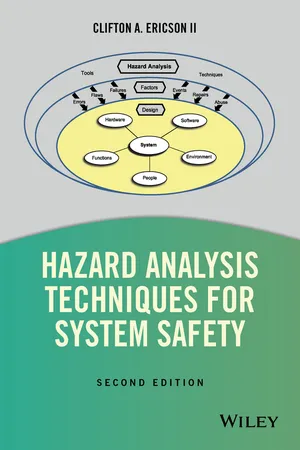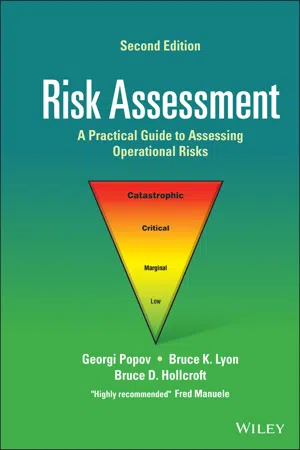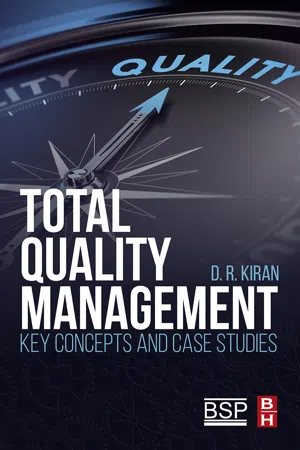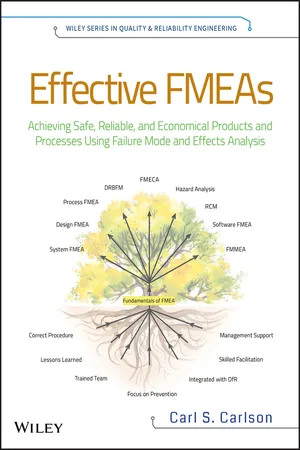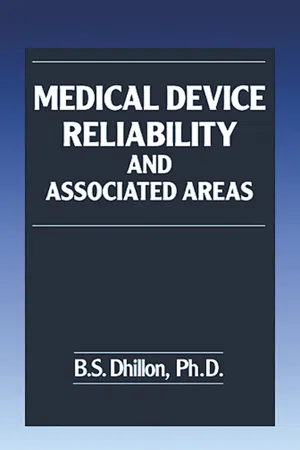Technology & Engineering
Failure Mode and Effects Analysis
Failure Mode and Effects Analysis (FMEA) is a systematic method for identifying and evaluating potential failure modes in a process, product, or system, and their potential effects. It helps to prioritize and address the most critical failure modes to improve reliability and safety. FMEA is commonly used in engineering, manufacturing, and other industries to proactively manage risks and enhance product quality.
Written by Perlego with AI-assistance
Related key terms
1 of 5
12 Key excerpts on "Failure Mode and Effects Analysis"
- eBook - ePub
- James E. Breneman, Chittaranjan Sahay, Elmer E. Lewis(Authors)
- 2022(Publication Date)
- Wiley(Publisher)
7 Failure Modes and Effects Analysis – Design and Process“You want a valve that doesn’t leak and you try everything possible to develop one, but the real world provides you with a leaky valve. You have to determine how much leaking you can tolerate.”Source: Arthur Rudolph, Saturn 5 Rocket Scientist7.1 Introduction
Failure modes and effects analysis , usually referred to by the acronym FMEA , is one of the most widely employed techniques for enumerating the possible modes by which components may fail and for tracing through the characteristics and consequences of each mode of failure on the system as a whole. The method is primarily qualitative in nature, although in Chapter 11 (Systems Safety Analysis) we introduce an extension of FMEA called FMECA (failure modes, effects and criticality analysis ) which includes estimates of failure probabilities.What is FMEA and why should this analysis be done? It is a tool for preventing problems and reducing risk as well as a procedure for developing and implementing new or revised designs, processes, or services. Finally, FMEA serves as a diary of the design, process, or service, valuable for future reviews of performance and dependability.In this chapter, we distinguish between three major types of FMEA: Functional FMEA addresses what happens if one or more of a product’s functions fail to be performed, and how can such failures be prevented. Design FMEA deals with what happens if a design shortcoming causes a product to fail, and how that failure can be prevented. Process FMEA examines what happens if a process step fails to accomplish its assigned task, and what can be done to prevent such a failure. Process FMEA (PFMEA - eBook - ePub
- Clifton A. Ericson, II(Authors)
- 2015(Publication Date)
- Wiley(Publisher)
Chapter 16 Failure Mode and Effects Analysis16.1 FMEA Introduction
Failure Mode and Effects Analysis (FMEA) is a tool for evaluating the effect(s) of potential failure modes of subsystems, assemblies, components, or functions. It is primarily a reliability tool to identify failure modes that would adversely affect the overall system reliability. FMEA has the capability to include failure rates for each failure mode, in order to achieve a quantitative probabilistic analysis. Additionally, the FMEA can be extended to evaluate failure modes that may result in an undesired system state, such as a system hazard, and thereby also be used for hazard analysis.A more detailed version of the FMEA is known as failure mode, effects, and criticality analysis (FMECA). The FMECA requires that more information be obtained from the analysis, particularly information dealing with the criticality and detection of the potential failure modes.FMEA is a disciplined bottom-up evaluation technique that focuses on the design or function of products and processes, in order to prioritize actions to reduce the risk of product or process failures. In addition, the FMEA is a tool for documenting the analysis and capturing recommended design changes. Time and resources for a comprehensive FMEA must be allotted during design and process development, when design and process changes can most easily and inexpensively be implemented.16.2 FMEA Background
FMEA falls under the detailed design hazard analysis type (DD-HAT) because it is an analysis done at the component or functional level based on detailed system design. The basic hazard analysis types are described in Chapter 4 .An alternate name for this technique is FMECA. FMECA is basically the same as FMEA, except that it adds criticality evaluation to each failure mode, as well as the evaluation of possible failure mode detection methods. - eBook - ePub
Risk Assessment
A Practical Guide to Assessing Operational Risks
- Georgi Popov, Bruce K. Lyon, Bruce D. Hollcroft(Authors)
- 2021(Publication Date)
- Wiley(Publisher)
8 Failure Mode and Effects Analysis Georgi Popov1 and Bruce Lyon2 1 University of Central Missouri 2 Brown & BrownOBJECTIVES
- Introduction, Overview, and Background
- Purpose and Use
- Practical Application
- Examples
- Practice Exercises/Questions
8.1 Introduction
Failure Mode and Effects Analysis (FMEA) is one of the most commonly used techniques for hazard analysis and risk assessment. As its name implies, FMEA is used to identify and analyze the ways in which system components can fail to fulfill their designed intent, and the resulting effects to the system. To state plainly, FMEA focusses on failures and their effects to understand how each failure can be prevented and their effects reduced. It is generally considered a qualitative or semiquantitative method that lists systematically the failure modes, their effects, existing safeguards, and any additional controls that are needed to reduce risk to an acceptable level.Traditionally, the FMEA method has been used as a form of “reliability” analysis of systems, subsystems, processes, and hardware. However, FMEA can also be used to analyze jobs and individual tasks, to identify potential deviations from desired performance criteria that can cause failures (exposure to hazards), how these failures can occur, and their resulting effect on the workers, as well as the work environment. This chapter will address the practical use of the FMEA technique in identifying failure modes and their effects, existing control measures, and ranking systems according to their importance or criticality. The text will provide qualitative and semiquantitative information for additional analytical techniques such as Bow‐Tie analysis.FMEA, one of the first failure analysis methods, was developed by the United States (US) Department of Defense (DoD) in 1949. It was originally published in the Military Procedure, MIL‐P‐1629 – Procedures for performing a failure mode effect and critical analysis, - eBook - ePub
Total Quality Management
Key Concepts and Case Studies
- D.R. Kiran(Author)
- 2016(Publication Date)
- Butterworth-Heinemann(Publisher)
Every product or project undertaken by the engineer is an experiment because each stage of the design or development is experienced for the first time. There are uncertainties at every stage, and the engineer is bound to make presumptions, either from data, books, or from his experience. These uncertainties can be in the form of:• models used for the design calculations,• performance characteristics of the materials,• inconsistencies in the materials purchased,• nature of the pressure the finished product will encounter,• size of the product, whether a medium-sized product or a large-sized product,• volume of production, viz, batch production or mass production,• specialized materials and skills used in the manufacture.Apart from the above, the engineer may also experience uncertainties from the viewpoint of several other variables in the development.26.2 Failure Modes and Effects Analysis
Failure Mode and Effects Analysis (FMEA) is one of the best management tools to analyze the potential failure modes within a system under conditions of uncertainties, as stated above. Its principle is quite basic, and has been practiced since the olden days as the trial and error method. But since learning from each failure is both costly and time-consuming, the modern form of FMEA was developed during the 1940s, as explained in the following section. It emphasizes the probability of occurrence of that failure, and the severity of its effect on the system of every uncertainty. It is used to identify potential failure modes, determine their effect on the operation of the product, and identify actions to mitigate the failures. It analyzes potential reliability problems early in the development cycle, where it is easier to take actions to overcome these issues, thereby, enhancing reliability through design. FMEA should always be done whenever failures would mean potential harm or injury to the user of the end item being designed. According to Besterfield et al., FMEA is a “before-the-event ” action requiring a team effort to easily and inexpensively alleviate changes in design and production - eBook - PDF
Six Sigma and Beyond
Design for Six Sigma, Volume VI
- D.H. Stamatis(Author)
- 2002(Publication Date)
- CRC Press(Publisher)
223 6 Failure Mode and Effect Analysis (FMEA) This chapter has been developed to assist and instruct design, manufacturing, and assembly engineers in the development and execution of a potential Failure Mode and Effect Analysis (FMEA) for design considerations, manufacturing, assembly processes, and machinery. An FMEA is a methodology that helps identify potential failures and recom-mends corrective action(s) for fixing these failures before they reach the customer. A concept (system) FMEA is conducted as early as possible to identify serious problems with the potential concept or design. A design FMEA is conducted prior to production and involves the listing of potential failure modes and causes. An FMEA identifies actions required to prevent defects and thus keeps products that may fail or not be fit from reaching the customer. Its purpose is to analyze the product’s design characteristics relative to the planned manufacturing or assembly process to ensure that the resultant product meets customer needs and expectations. When potential failure modes are identified, corrective action can be initiated to eliminate them or continuously reduce their potential occurrence. The FMEA also documents the rationale for the manufacturing or assembly process involved. Changes in customer expectations, regulatory requirements, attitudes of the courts, and the industry’s needs require disciplined use of a technique to identify and prevent potential problems. That disciplined technique is the FMEA. A process FMEA is an analytical technique that identifies potential product-related process failure modes, assesses the potential customer effects of the failures, identifies the potential manufacturing or assembly process causes, and identifies significant process variables to focus controls for prevention or detection of the failure conditions. - eBook - ePub
Effective FMEAs
Achieving Safe, Reliable, and Economical Products and Processes using Failure Mode and Effects Analysis
- Carl Carlson, Carl S. Carlson(Authors)
- 2012(Publication Date)
- Wiley(Publisher)
Chapter 3 Understanding the Fundamental Definitions and Concepts of FMEAs Intellectuals solve problems, geniuses prevent them. —Albert EinsteinIN THIS CHAPTER
What exactly is Failure Mode and Effects Analysis (FMEA) and what are its key concepts and definitions? This chapter explains the different types of FMEAs and tells how each is used. The majority of the chapter covers a thorough explanation of the key words and concepts of FMEA, each illustrated with multiple application examples for different types of FMEAs.3.1 DEFINITION OF FMEA
Failure Mode and Effects Analysis (FMEA) is a method designed to:- Identify and fully understand potential failure modes and their causes, and the effects of failure on the system or end users, for a given product or process.
- Assess the risk associated with the identified failure modes, effects, and causes, and prioritize issues for corrective action.
- Identify and carry out corrective actions to address the most serious concerns.
An FMEA is an engineering analysis done by a cross-functional team of subject matter experts that thoroughly analyzes product designs or manufacturing processes early in the product development process. Its objective is finding and correcting weaknesses before the product gets into the hands of the customer.An FMEA should be the guide to the development of a complete set of actions that will reduce risk associated with the system, subsystem, and component or manufacturing/assembly process to an acceptable level.Performing an FMEA just to fill a checkbox in the Product Development Process and then filing it away, never to be seen again, is a waste of time and adds no value. If not for use as guidance through the development process, why waste the time and resources to do it in the first place? If effectively used throughout the product life cycle, it will result in significant improvements to reliability, safety, quality, delivery, and cost. - eBook - ePub
Designing High Availability Systems
DFSS and Classical Reliability Techniques with Practical Real Life Examples
- Zachary Taylor, Subramanyam Ranganathan(Authors)
- 2013(Publication Date)
- Wiley-IEEE Press(Publisher)
prior to test or deployment. The DFMEA technique is intended to detect design deficiencies or errors that have been embedded into a design or inherent in the operating environment and provide recommendations for corrective action to minimize unacceptable risks. By providing a rigorous, systematic, and proven methodology, DFMEA increases the probability that the majority of potential failure modes and their effects have been considered and mitigated during the design/development process.DFMEA provides a framework to identify, classify, and rank the various failures based upon certain criteria, details of which are described in this chapter. This technique is a general approach to prioritizing any set of risks or issues by quantifying what might otherwise be very subjective opinions. DFMEA provides additional rigor and structure to failure analysis and is a well-known and validated process used for designing high availability systems:- Requires that all known or suspected potential failures be considered.
- Relies on the collective expertise of the technical leaders representing all areas impacted by the functionality.
- Stimulates open communication of potential failures and their outcomes.
- Results in actions that improve product robustness and reliability.
- Alignment of product capabilities with customer requirements.
- Bringing an outside-in perspective by involving test and field support.
15.3 Definitions
The American Society for Quality (http://www.asq.org ) provides the following FMEA definitions:FMEA. A systematized group of activities to recognize and evaluate the potential failure of a product or process and its effects, identify actions that could eliminate or reduce the occurrence of the potential failure, and document the process.Failure Modes. The ways (modes) in which something might fail—especially ones that affect the customerEffects Analysis. - eBook - ePub
Aircraft System Safety
Assessments for Initial Airworthiness Certification
- Duane Kritzinger(Author)
- 2016(Publication Date)
- Woodhead Publishing(Publisher)
5Failure Modes and Effects Analysis
Abstract
An Failure Modes and Effects Analysis (FMEA) is a systematic ‘bottom-up’ method of (1) identifying single failure modes and failure probabilities of a system, item, function, or piece-part (i.e. smallest individual part or component); (2) determining the effects of this failure mode on the next higher level of the design (if available to the assessor, i.e. an LRU supplier will not know how much redundancy the system integrator is going to build into his system); and (3) classifying failure modes according to the worst case severity of the end effect.Keywords
Compensating provisions; Failure criticality; Failure detection method; Failure effect; Failure mode; FMEA; FMECA; Functional Block Diagram; Functional FMEA; Piece-part FMEA; Prioritise; Process FMEAFailure is the rule rather than the exception, and every failure contains information. Steve Wozniak (Apple co-founder)5.1. Introduction
In this chapter we explore the Failure Modes & Effects Analysis (FMEA) and the Failure Modes Effects & Criticality Analysis (FMECA) which, as the name suggests, simply is an extension of the FMEA.1 This chapter will use the acronym FMEA and highlight those instances where is extended to include FMECA.5.1.1. Background
An FMEA is a systematic ‘bottom-up ’ method of:• identifying single failure modes and failure probabilities of a system, item, function or piece-part (i.e. smallest individual part or component);• classifying failure modes according to the worst case severity of the end effect (FMECA only).• determining the effects of a failure mode on the next higher level of the design (if available to the assessor as an LRU supplier will not necessarily know how much redundancy the system integrator is going to build into his system);The FMEA approach has been around for a very long time. Before any documented format was developed, inventors and process experts would try to anticipate what could go wrong with a design or process before it was developed or tried. The FMEA discipline was first formalised in the late 1940s by the US Military (refer MIL-P-1629A - B.S. Dhillon(Author)
- 2000(Publication Date)
- CRC Press(Publisher)
The method is named after a Russian mathematician. The common-cause failure analysis method is basi-cally a block diagram approach used to analyze systems with common-cause failures. It was developed during the middle of the 1970s. 5,6 A common-cause failure is any instance where multiple units or components fail due to a single cause. This chapter describes in detail all of the above methods. 3.2 FAILURE MODE AND EFFECT ANALYSIS (FMEA) This is a bottom-up approach, and its objective is to improve items/system reliability during the design phase by identifying all conceivable and potential failure modes and determining the effect of each on system/item performance. FMEA is known as failure mode effects and criticality analysis (FMECA) when critical analysis (CA) is added to it. 7-9 CA may simply be described as a quantitative approach used to rank critical failure mode effects by considering their occurrence probability. A comprehensive list of publications on FMEA is given in reference 10. 3.2.1 I MPORTANT T ERMS AND D EFINITIONS As there are many terms and definitions involved to perform FMEA/FMECA, this section presents some of the important ones: 7 • Failure mode . This is the manner through which a failure is observed. More specifically, it usually describes the way the failure occurs and its effect on item/system operation. • Criticality . This is a relative measure of a failure mode consequences and its occurrence frequency. • Failure cause . This is design defects, physical or chemical processes, part misapplications, quality defects, or other processes that are the primary reason for failure or which start the physical process through which deterioration leads to malfunction or failure. • Failure effect . This is the consequence or consequences of a failure mode on the operation, function, or status of an item/system.- eBook - ePub
Quality Planning and Assurance
Principles, Approaches, and Methods for Product and Service Development
- Herman Tang(Author)
- 2021(Publication Date)
- Wiley(Publisher)
Time commitment from all members is crucial to the success of an FMEA because the work itself and reaching a team consensus can be time consuming. For example, the cross-functional teams of an automaker worked on process FMEAs on a weekly basis for six months. Thus, proper planning should be conducted allowing sufficient time to do FMEAs. Many companies have requirements on FMEA, but do not have the dedicated budget or time for FMEA development. Rushing on filling out an FMEA form, e.g. doing cut and paste from similar FMEAs, one person doing everything and then the team approving it, and preparing paperwork just to satisfy a customer or external audit, can cause an FMEA to be less valuable. As a result, an FMEA would serve merely as documentation, rather than a tool that can be used to predict and prevent problems and reduce risks.Data and Other Issues in FMEA
FMEA is also data driven; thus obtaining sufficient amounts of information is essential. This information, from benchmarking, customer warranty reports, field complaints, other failure analyses, and previous lessons learned, etc., is important to predict and analyze potential failure modes. Because the design of a product or service is prior to process planning in development, a design FMEA should be conducted first, and its outputs become the inputs to a process FMEA. For example, the major failure modes identified from a design FMEA, if not preventable, should be addressed in the corresponding process FMEA for detection and control, as shown in Figure 5.12 . Manufacturing engineers determine and design the monitoring and/or control processes into manufacturing production for such design failure modes.Relationship between design FMEA and process FMEA.Figure 5.12Not every FMEA is successful, even with well-documented files. One can justify FMEAs only based on their contributions to the success of a product or service. A few studies have been conducted on existing FMEA applications (Johnson and Khan 2003; Spreafico et al. 2017). The issues they found were related to the subjectivity, time consumption, understanding of cause-effect, and data management, etc. These studies indicated the difficulty in quantifying the true benefits of FMEAs in terms of costs, reliability improvements, and problem prevention. - eBook - ePub
Reliability Culture
How Leaders Build Organizations that Create Reliable Products
- Adam P. Bahret(Author)
- 2021(Publication Date)
- Wiley(Publisher)
10 Risk Analysis Guided Project ManagementWe have limited resources and limited time. We would like to select and adhere to a method to choose where to apply resources. I firmly believe that assessed risk is the best way to do this. Using risk assessment to guide program activities is a process of:- Selecting tools that can translate product performance and program success risk to quantitative values.
- Use these values to prioritize the most critical areas of the product and program to address.
- Create a summary of these quantitative risk rankings that assigns specific tools to measure and mitigate these risks.
- Create a program plan that applies the available resources to these items in rank order until time and resources run out.
Failure Mode Effects Analysis Methodology
A Failure Mode Effects Analysis (FMEA ) looks to take speculative failure modes and their effects and make them quantifiable so that they can be ranked from highest to lowest risk. FMEAs can be used in programs for many purposes.I have noticed in my career that simply uttering the word FMEA creates a “cringe” in the room. I would believe that if I were to choose the phrase that best describes how many teams feel about FMEAs it would be what was said to me after I did a “lunch and learn.” “I get what you are saying about the value of FMEAs, but we have been a bit traumatized by them in the past.” Traumatized?! The team lead actually used the word “traumatized.”But that is not an uncommon experience and the negative effects are real. FMEAs are a true double‐edged sword. I sincerely believe they are one of the most valuable cornerstones to any reliability and product development program, if done correctly. Like anything else that is powerful, it's just as easy to cut off your own leg with it if you don't know what you are doing.Simply put, a badly run FMEA is something you would wish upon your competitors. It wastes time, drains morale, and doesn't provide any valuable program or design input. What more could you hope for for the other guy with a product next to yours on the store shelf? - eBook - ePub
- Louis J. Gullo, Jack Dixon(Authors)
- 2017(Publication Date)
- Wiley(Publisher)
Chapter 16 of this book, as well as an example of software failure causes for potential software failure modes. We provide potential software failure mode effects for software elements of a navigation system.8.5 What Is a PFMECA?
FMECA is a tool used for addressing risk of hazards or failures. In the case of the D‐FMECA it is extremely valuable in reviewing the design aspects of a product—from the standpoint of the ability to investigate possible issues for the product meeting its design requirements. Just as the D‐FMECA focuses on possible design failure modes at multiple levels of hardware or software structure, Process Failure Modes, Effects, and Criticality Analysis (PFMECA) is a detailed study, focused on manufacturing and test processes and steps, required to build reliable products. It includes review of materials, parts, manufacturing processes, tools and equipment, inspection methods, human errors, and documentation. It reviews the build, inspection effectiveness, and test aspects of the product for possible risks of process step failures at multiple levels of processes, including the severity of problems after the product is in the customer’s hands.8.5.1 What Is the Difference Between a Process FMECA and a Design FMECA?
Process FMECA (PFMECA) is an FMECA that assesses the failure modes and failure causes related to the manufacturing process or the design process. The design process (D‐FMECA) is an FMECA that assesses the failure modes and failure causes related to the system or product design.The PFMECA process is broken down into sub‐processes and lower level steps. For each step, possible problems, their likelihood of occurring and their ability to be detected before extensive consequences are explored. The impacts to the customer, as well as to subsequent sub‐processes, are considered. Throughout this process, a matrix is used to help define the scope of effort, track the progress of the analysis, document the rationale of each entry, and facilitate quantification of the results. Figure 8.4
Index pages curate the most relevant extracts from our library of academic textbooks. They’ve been created using an in-house natural language model (NLM), each adding context and meaning to key research topics.

